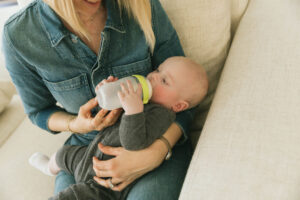Tips for Handling the Formula Crisis
These past couple of months have been so unbelievably hard for formula-feeding parents and caregivers. The DMs, texts, and emails we have been receiving break our hearts. Even when we have an ample supply of formula, feeding our babies is hard, and this extra anxiety about finding formula is something no one should ever experience. We know you are going to exhausting lengths to get what your baby needs, and we want to help you navigate this safely until formula is back on the shelves.

Tips for Handling the Formula Crisis
Written by: Jessica Diamond, MPH, RDN
These past couple of months have been so unbelievably hard for formula-feeding parents and caregivers. The DMs, texts, and emails we have been receiving break our hearts. Even when we have an ample supply of formula, feeding our babies is hard, and this extra anxiety about finding formula is something no one should ever experience. We know you are going to exhausting lengths to get what your baby needs, and we want to help you navigate this safely until formula is back on the shelves.
As always, please consult with your pediatrician given that every baby is different. This is not meant to serve as medical advice.
Finding your usual formula
The one thing that has become apparent during this crisis is the power of community, especially the power of the parenting community. Influencers in the formula community have stepped up to connect parents with extra formula with those who are running low. Here are two community exchanges where you can send extra formula to a family in need or purchase the formula you are looking for from parents across the country.
- @theformulamom has created a formula exchange program here.
- @theformulafairy has a Facebook exchange here.
We’ve always said that the parenting community is unlike any other community, but the way parents are supporting each other right now is truly incredible.
Still not finding formula?
- Reach out to your pediatrician, your OBGYN, and/or your local hospital as they may have supplies and in-office samples on hand.
- You can also look for formula brands that are more available right now, like Kabrita, Baby’s Only, Earth’s Best, Happy Baby Organics, Rite-Aid Tugaboos Infant Formula, and Gerber Goodstart Gentle. (As of this writing, ByHeart and Bobbie, which normally are more available, have paused new subscriptions.)
- Contact your local Community Action Agency: your neighborhood CAA may be able to provide you with formula or connect you with local agencies that have formula in stock.
- You can try nutritionally-appropriate toddler formula if your pediatrician approves. (Kabrita and Baby’s Only are brands that meet FDA nutrient requirements for infants.)
- You can try imported infant formulas, like those from Canada and Europe, that have instructions in English and nutrient profiles similar to our FDA guidelines. Hipp, Lebenswert Holle, and Loulouka are well-known imported brands.
- You can try donor milk: certain HMBANA-accredited milk banks are distributing donated breast milk to mothers in need. (This may require a prescription from a medical professional.)
- You can contact manufacturers and other resources using the government’s Helping Families Find Formula During the Shortage Fact Sheet.
Trying a new formula
We know what it feels like to be really loyal to a certain formula brand. Once we find one that works for our baby, there’s not much that can get us to switch! But switching might be necessary given the formula shortage, so here’s some tips so you can try not to stress so much about changing brands right now.
- Try a different formula type, like powder, ready-to-feed, or concentrate. Most babies can tolerate a different formula type of the same formula. (One exception here is Alimentum Ready to Feed because those ingredients are very different from the powder.)
- Try a generic brand that’s equivalent to the formula you have been using. Many generic formulas have the exact same formulation as the name brand (e.g., RiteAid’s Gentle formula is the same as Target’s Up & Up Gentle formula, which is the same as Parent’s Choice Gentle formula). Compare nutrition labels to find similar formulations, and if you want more help check out this resource to make the transition to the new brand as smooth as possible.
- Try a prior version of your formula. Formula companies get fancy with their specialized formulas, but many times, their old version is very similar to their new and improved version (e.g., Gerber Goodstart GentlePro is very similar to Gerber Goodstart Gentle.)
- Try a totally new formula. When picking a new formula, start with a formula that has the same carbohydrate source and protein source as the formula you were using before. This is especially important if your baby has a sensitive stomach because it will minimize gas and other GI discomfort. But, if your baby tolerates formula really well and doesn’t have a known allergy, you can try new formulas with different protein and carbohydrate sources than your current formula.
Formula comes in many different “categories” from standard formulas to really specialized hypoallergenic formulas so when making a switch, always try to find a formula that is in the same “category” as your current formula. As much as possible, try to leave the more specialized formulas for babies who have conditions requiring them. Here are the categories from standard to the most specialized: standard → gentle → sensitive (these have reduced lactose or are lactose-free and some hydrolyzed protein) → hypoallergenic (these are lactose-free and extensively hydrolyzed protein) → elemental or amino acid (these are the most specialized and are lactose-free, dairy-free, and hydrolyzed proteins).
Common temptations and things to avoid
- No matter how desperate you get, don’t dilute formula. We completely get the impulse to add more liquid to formula to stretch it out, but diluting formula can lead to serious health problems. Formula has a very delicate balance of nutrients, vitamins, and minerals, and disrupting that balance with extra liquid can lead to electrolyte imbalances, impaired growth and development, and in some cases, seizures and more severe health problems.
Follow the instructions exactly as they appear on the formula. Using the scoop that comes with the formula, precisely measure out the number of scoops needed. For more information on the basics of formula for babies, check out our article here.
- Don’t make homemade formula. We understand that parents are absolutely panicked right now, and if there was a way to make formula safely at home, we would be the first to give you the recipe. Unfortunately, homemade formula can be risky in both the short and long term. It has been associated with:
- Severe nutritional deficiencies that lead to poor weight gain, inadequate brain development, poor growth, and anemia
- Contamination and infection like salmonella and E. coli
- Electrolyte disturbances that can lead to seizures, brain damage, and heart problems
- Nutrient excess that can lead to kidney damage and dehydration
We’ve listed these risks because they are very real and are much more significant than the risks associated with the other options listed in this article.
- Water and/or solid foods aren’t a replacement for formula. Once you’ve started solid foods, it’s really tempting to offer more water and food in place of formula. The problem is that food provides only ~5-10% of your baby’s nutritional needs before 12 months. On the other hand, formula provides the right amount of nutrients, vitamins, and minerals needed for growth and development in that first year. So, while it’s fine to offer your baby more food, you’ll need an adequate amount of formula to meet the vast majority of their nutrient needs.
In the first year, water is really best for practice with drinking from a cup. Giving your baby too much water can displace formula intake and have the same effect as diluting formula with water (e.g., seizures, growth impairment, and electrolyte imbalances). The recommended amount of water for babies 6-9 months is less than 4 ounces per day, and for babies 9-12 months, it’s less than 8 ounces per day. And if you want more information on water and cup drinking for your baby check out this article.
- Don’t buy formula from an online marketplace like eBay or Craigslist: When you get formula from a third-party seller, you can’t be sure that the product you are buying is the product they are selling. There are a lot of scams and price gouging out there, so be sure to buy your formula from a trusted source.
While the government has taken measures in recent days to increase the infant formula supply in the United States, it is clear that the formula shortage will continue to affect thousands and thousands of parents. So, until there’s enough formula for every parent to confidently find formulas, we hope you will find these tips helpful.






